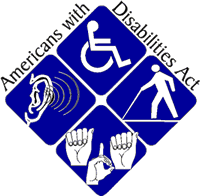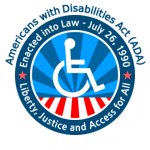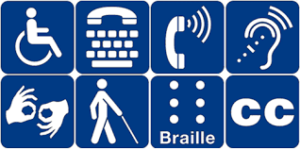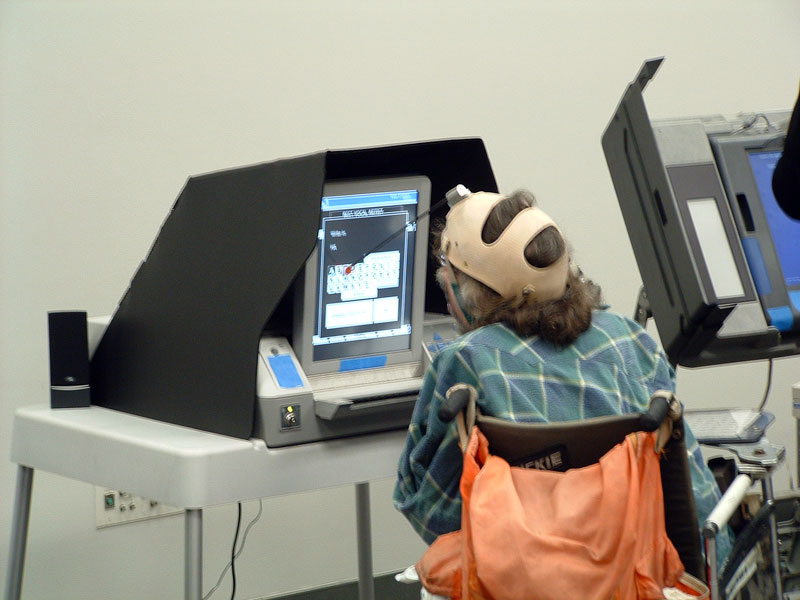


The Americans with Disabilities Act (ADA) is a milestone civil rights law that prohibits discrimination against people on the basis of disability. This chart will review the provisions of this law and will give examples of how the law is applied.
Definitions
Disability – a physical or mental impairment that substantially limits one or more major life activity.
– Includes people who have a record of having a disability, even if they currently don’t have one.
– Includes people who do not have a disability but are regarded as having one.
– Makes it unlawful to discriminate against a person based on his or her association with a person with a disability.
– Conditions do not have to be severe or permanent to be defined as disabilities.
– Conditions that are considered anti-social, as well as other specific conditions, are excluded. Examples of anti-social conditions include pedophilia, exhibitionism, and others. Gender identity disorder is an example of a specific condition that is excluded.
Covered entity – an employer who employs more than 15 employees, an employment agency, a labor organization, or a joint labor-management committee.
Public entity – a federal, state, or local agency that is run by or funded by government.
– State legislatures, county government, city government, village or town boards
– Public school districts
– Public transportation
– State and local public housing, housing assistance, and housing referrals
Public accommodation/Commercial facility – all buildings that house places of business or recreation that are open to the public.
– Hotels, motels, and inns
– Recreational facilities – swimming pools, fitness centers, indoor sports facilities
– Transportation
– Educational facilities – public or private schools, universities, and conference centers
– Restaurants
– Shopping centers, stores and other businesses
– Private clubs and religious organizations are not included
– Historic places are included with provisions to preserve the historic significance of the building.
Reasonable accommodation – a necessary and appropriate modification or adjustment that allows people with disabilities to participate on an equal basis with others.
– Must not impose an undue burden on the covered or public entity.
Readily achievable – easy to accomplish without much difficulty and expense.
This video made to commemorate the 20th anniversary of the ADA in 2010 gives an excellent overview of the impact the ADA has had on the rights of people with disabilities in the United States.
Titles
The following chart provides a summary of the 5 Titles of the ADA.
| Title | Main Points | Examples | Video |
| I – Employment | Prohibits private employers, state and local governments, labor unions, and employment agencies from discriminating against qualified individuals with disabilities.
-covers employers with 15 or more employees |
A teacher who sustained a head injury is still able to fulfill his job duties, but becomes groggy and experiences difficulty with executive functions at midday. He is able to regain his mental processing abilities if he is allowed to take a short nap. The high school where the teacher works allows the teacher to keep a cot in his storage room and arranges his schedule so that his prep period falls at midday. The teacher uses his prep period to take a nap. The allowance of the cot and the custom scheduling are reasonable accommodations that the school has provided the teacher so that he can work in spite of his head injury. | Video from the District of Columbia Office of Disability Rights explaining Title I of the ADA, including a description of reasonable accommodations. |
| II – State and Local Government | Prohibits state and local government entities from discriminating against individuals with disabilities in relation to programs, services and activities provided by government entities.
-includes activities and services provided at the state, county, and municipal levels |
A city sponsored baseball league allows a player who uses an upper extremity prosthesis to use an adapted glove and to bat one handed. The player is able to perform all of the functions of the other players on the team with these adaptations.
A county courthouse removes four seats at the end of seating rows in each of its court rooms to allow space for courtroom attendees who use wheelchairs. |
A cute student video that explains Title II of the ADA. |
| III – Public Accommodations and Commercial Facilities | Prohibits business and facilities that are open to the public from discriminating against people with disabilities.
-includes the mandate that all public accommodations and commercial facilities remove architectural barriers that prevent access by people with disabilities. |
A newly constructed shopping center includes ramps at the sides of entrance stairways and elevators in three areas that provide access to all floors.
A historic museum is not required to change its iconic front entrance steps, but is required to install ramps at two side entrances to allow access for people with disabilities. |
Explanation of how Title III of the ADA applies to private hospitals and other health care facilities. |
| IV – Telecommunications | Requires all telecommunications companies in the United States to ensure functionally equivalent services for people with disabilities.
-applies primarily to people who are deaf, hard of hearing, or have speech impairments. |
A woman with a severe hearing impairment is able to use her TDD device and captioned video conferencing through the services provided by her local telephone company. | A student video demonstrates Titles IV and V of the ADA. |
| V – Miscellaneous Provisions | Includes technical provisions -stipulates that the ADA does not override other pieces of legislation pertaining to disabilities, such as Section 504 of the Rehabilitation Act of 1973. -protects people who exercise their rights under the ADA from retaliation. |
An employer who has been required to provide an employee with multiple sclerosis a modified schedule and a workstation that allows him to sit to work is prevented from retaliating against the employee by forcing him to pay for the work station. | A video produced in ASL explains Title V of the ADA. |

| Title | Intervention Strategies | Examples | Photo/Video |
| I – Employment | -Provide consulting services to employers regarding the provisions of the ADA, what is required, and what is considered unreasonable or unnecessary. -Complete job analysis and work station analysis and provide recommendations. -Advocate on behalf of patients with disabilities as they return to work. |
An occupational therapist presents an in-service to management at a local manufacturing company about the definition of reasonable accommodations under the ADA.
An occupational therapist analyzes the workstation of a secretary who has a diagnosis of carpal tunnel syndrome and recommends an adjustable chair and ergonomic keyboard. |
Occupational therapy students explain the role of occupational therapy in work environments. |
| II – State and Local Government | -Provide consulting services to government entities regarding access to government buildings and services. -Analyze existing government facilities for accessibility and provide recommendations. |
An occupational therapist recommends that the screen reader on one or two computer stations be enabled for visually impaired adults using the services provided at the county run job center. | The head of Penn State’s disability services explains the importance of Title II for students with disabilities attending public universities. |
| III – Public Accommodations and Commercial Facilities | -Analyze the accessibility of new and existing buildings and provide recommendations to architects and contractors. | An occupational therapist provides recommendations to an architect who is renovating an older shopping mall to improve accessibility.
An occupational therapist recommends a chair lift to an antique mall located in a historic building with a second story. |
Demonstration of how to assess public areas for ADA compliance under Title III. |
| IV – Telecommunications | -Provide information to patients with newly acquired hearing or speech impairments on how to access telecommunication services. -Assist patients in overcoming any additional barriers to using adaptive telecommunication devices. |
An occupational therapist provides information about telecommunication services available at the local telephone company to a patient with a newly diagnosed hearing impairment. | A demonstration of a doctor’s office calling a patient using TTY service. |
| V – Miscellaneous Provisions | -Educate patients regarding their rights under the ADA | An occupational therapist educates a patient on her rights at work after the patient tells the therapist that her employer will not allow her the reasonable accommodation of sitting on a stool at her cash register. | A lawyer explains the process that employees and employers should follow to insure that reasonable accommodations are provided. |